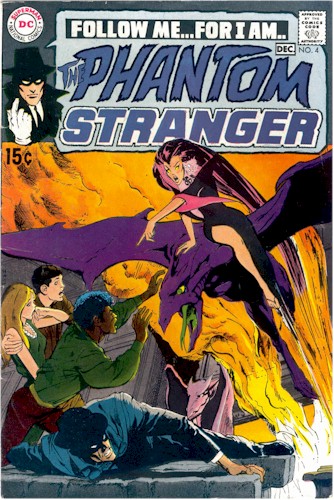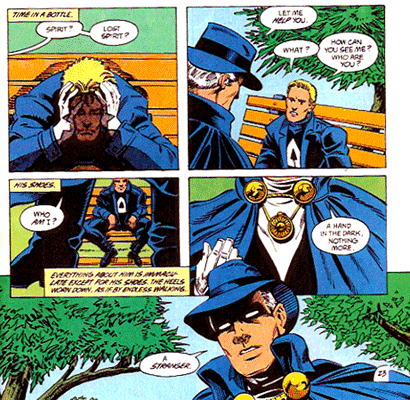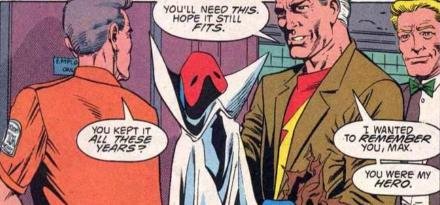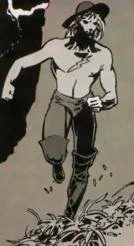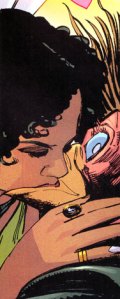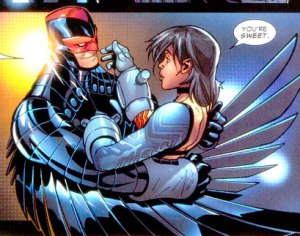Archive for the ‘Underrated Underdogs’ Category
 Much like the old characters from Charlton, Fawcett, Milestone, and MLJ Comics, DC has recently acquired the full rights to the T.H.U.N.D.E.R. Agents team and is folding them into the DCU in their own title. Before I get into a review of T.H.U.N.D.E.R. Agents #1, however, I should probably tell you a bit about their extremely convoluted history.
Much like the old characters from Charlton, Fawcett, Milestone, and MLJ Comics, DC has recently acquired the full rights to the T.H.U.N.D.E.R. Agents team and is folding them into the DCU in their own title. Before I get into a review of T.H.U.N.D.E.R. Agents #1, however, I should probably tell you a bit about their extremely convoluted history.
Created by artist Wally Wood, the team originally appeared in November 1965’s T.H.U.N.D.E.R. Agents #1 published by Tower Comics. For a while the T.H.U.N.D.E.R. (acronym for The Higher United Nations Defense Enforcement Reserves) Agents consisted of NoMan, Dynamo, Lightning, and Menthor, four heroes who were given powers by an invisibility cloak, a strength-enhancing belt, a speedster suit, and a telepathy helmet respectively. Only problem was that the power-granting items also slowly killed their users. Other heroes came and went (like Sea Devils rip-off sister team, U.N.D.E.R.S.E.A. Agents) before the series ended at issue #20 and Tower Comics folded.
For years, the team remained dormant (aside from a British publisher, L. Miller & Son, Ltd., reprinting the original issues in black and white sometime during the mid-70s) until John Carbonaro bought the rights in 1983 and planned on rebooting the series (with the aid of David Singer) on his own JC Comics. Unfortunately, he and Singer had a serious falling out and Carbonaro only got as far as two issues before JC Comics fell through. That same year, Texas Comics released Justice Machine Annual #1, the only issue they ever produced, which featured a team-up story between the T.H.U.N.D.E.R. Agents and their in-house superhero team, the Justice Machine.
 In 1984, Singer and Deluxe Comics claimed that the T.H.U.N.D.E.R. Agents were now in public domain (bullshit!) and began releasing a series under the name Wally Wood’s T.H.U.N.D.E.R. Agents with a fantastic line-up of artists including George Pérez, Steve Ditko, Keith Giffen, and Jerry Ordway. Unfortunately for him, Carbonaro still owned the rights and sued the shit out of Singer and Deluxe Comics, ultimately winning the suit and putting them out of business in 1986.
In 1984, Singer and Deluxe Comics claimed that the T.H.U.N.D.E.R. Agents were now in public domain (bullshit!) and began releasing a series under the name Wally Wood’s T.H.U.N.D.E.R. Agents with a fantastic line-up of artists including George Pérez, Steve Ditko, Keith Giffen, and Jerry Ordway. Unfortunately for him, Carbonaro still owned the rights and sued the shit out of Singer and Deluxe Comics, ultimately winning the suit and putting them out of business in 1986.
In 1987, Gary Brodsky, son of Marvel legend Sol Brodsky, attempted to release a four-issue black-and-white limited series through his own Solson (Sol’s Son, get it?!) Publications. One issue was released before the company went belly-up (probably because most of their books were either right-wing propaganda or anti-feminist screeds). FUN FACT: Following the demise of Solson Publications, Gary decided to make a series of videos teaching guys how to pick up women with titles like “Alpha Up and Rock Her World” and “How to Be a Prick Women Love.” Seriously. Look at his fucking website.
Rumor has it that in the 1990’s Rob Liefeld claimed the rights to the T.H.U.N.D.E.R. Agents and wanted Dave Cockrum to release a series on Liefeld’s Extreme Studios before it fell through. If that’s true, it’s a bit strange considering that Carbonaro still owned the rights to the superhero team, going so far as releasing a final story in 1995 in Penthouse Comix’s (yup, that Penthouse) OMNI Comics #3.
Finally, some time during the early 2000’s, Carbonaro and DC Comics struck a deal and a DCU T.H.U.N.D.E.R. Agents book was in the works. Well, it would have been, except Carbonaro shot down every idea DC presented to him. See, DC really wanted to shake things up for the team while Carbonaro decided that nobody from the original team should die (despite the fact that the whole point of the T.H.U.N.D.E.R. Agents was that their powers would ultimately kill them). Aside from a few DC Archive hardcovers and a couple of statues, nothing really came of it.
On February 25, 2009, John Carbonaro died. July 2009, DC Comics announced at SDCC that they were moving forward with a T.H.U.N.D.E.R. Agents book. Yesterday, it came out.
So, how is it?
 Written by Nick Spencer (Shuddertown, Existence 2.0), T.H.U.N.D.E.R. Agents #1 tells the story of the United Nations scrambling to replace the recently deceased Lightning and Dynamo following a trap set by S.P.I.D.E.R. (the villains from the original Tower Comics run). Without explaining too much about the original team, it sets up the premise that the original NoMan and the new replacement members must save Raven (another Tower Comics character) from S.P.I.D.E.R. It’s surprisingly engaging, considering that the team hasn’t had a proper canon story since the 80’s outside of Penthouse (man, how I wish I were joking). As odd as it sounds, the book does a good job establishing the team without giving the its members a proper introduction, instead focusing on the staff behind the T.H.U.N.D.E.R. Agents (so, I guess whatever “The Higher United Nations” is). Plus, the art by the single-named duo of CAFU (Vixen: Return of the Lion) and BIT (Batman and the Outsiders) is pretty damned good (if you can overlook the fact that everybody looks like they’re wearing crazy amounts of eyeliner).
Written by Nick Spencer (Shuddertown, Existence 2.0), T.H.U.N.D.E.R. Agents #1 tells the story of the United Nations scrambling to replace the recently deceased Lightning and Dynamo following a trap set by S.P.I.D.E.R. (the villains from the original Tower Comics run). Without explaining too much about the original team, it sets up the premise that the original NoMan and the new replacement members must save Raven (another Tower Comics character) from S.P.I.D.E.R. It’s surprisingly engaging, considering that the team hasn’t had a proper canon story since the 80’s outside of Penthouse (man, how I wish I were joking). As odd as it sounds, the book does a good job establishing the team without giving the its members a proper introduction, instead focusing on the staff behind the T.H.U.N.D.E.R. Agents (so, I guess whatever “The Higher United Nations” is). Plus, the art by the single-named duo of CAFU (Vixen: Return of the Lion) and BIT (Batman and the Outsiders) is pretty damned good (if you can overlook the fact that everybody looks like they’re wearing crazy amounts of eyeliner).
Here’s hoping that where the Red Circle books kind of petered out, the T.H.U.N.D.E.R. Agents can take a seat next to the rest of the DC Comics greats.
 Even if you’ve never read or seen 2001: A Space Odyssey, chances are pretty good you know about HAL 9000 and his shenanigans. Something you probably didn’t know, however, was that it apparently took place on Earth-616.
Even if you’ve never read or seen 2001: A Space Odyssey, chances are pretty good you know about HAL 9000 and his shenanigans. Something you probably didn’t know, however, was that it apparently took place on Earth-616.
“What the hell are you talking about?” asked the entire Internet.
Well, from 1976 to 1982, Marvel would occasionally release comic book adaptations to TV shows and movies written and illustrated by some industry heavyweights under the banner “Marvel Treasury Special.” The first book to carry this banner was the 84-page 2001: A Space Odyssey, written and drawn by Jack Kirby (released a full 8 years after the film’s release).
In December 1976, Kirby began writing a ten-issue limited series also called 2001: A Space Odyssey which expanded on the story a bit. July 1997’s 2001: A Space Odyssey #8, tells the story of Dr. Oliver Broadhurst’s experiments regarding artificial life. After a bunch of his robots suffer existential crises and lash out, General Joeseph Kragg orders him to destroy the whole lot. Unbeknownst to him, fellow scientist Abel Stack has stolen robot X-51 (aka Aaron Stack aka Mister Machine aka Machine Man) and is in the process of removing his self-destruct mechanism when the flip is switched, killing Abel. The military shows up and captures X-51, but he is immediately freed and granted sentience by one of those big monolith things. The rest of the limited series is all about X-51 running away from Kragg’s men, ending in September 1977.
But Kirby wasn’t done yet. April 1978 saw the release of Machine Man #1, continuing the story of X-51 evading Kragg. In issue #4, Earth gets invaded by an alien robot named Ten-For (Kirby loved him some alien invasions) and X-51 jumps in and defeats him. Kragg decides that X-51 isn’t that bad a robot after all and, by the books cancellation with December 1978’s Machine Man #9, they were BFFs.
In April 1979’s Incredible Hulk Vol 1 #234, Hulk’s buddy Trish Star gets kidnapped by a bunch of thugs, one of which is wearing a purple jumpsuit. Since Hulk is a blathering idiot, he immediately sets out to fight X-51 (proving that everything up till now takes place on Earth-616). Incredible Hulk #235-237 are standard “Hulk vs. Hero X” fare (couple issues of fighting and then everybody walks away).
 After the conclusion of that storyline, Marvel renewed the Machine Man series under Marv Wolfman and Steve Ditko with August 1979’s Machine Man #10. Dr. Broadhurst attempts to repair the damage caused by Hulk and, in doing so, takes away all of X-51’s offensive weapons. Tom DeFalco took over for Marv Wolfman with issue #15 and immediately started integrating more Marvel characters into the title. The series ended with February 1981’s Machine Man #19 (which was also first appearance of Jack O’Lantern and had a pretty rad Frank Miller cover).
After the conclusion of that storyline, Marvel renewed the Machine Man series under Marv Wolfman and Steve Ditko with August 1979’s Machine Man #10. Dr. Broadhurst attempts to repair the damage caused by Hulk and, in doing so, takes away all of X-51’s offensive weapons. Tom DeFalco took over for Marv Wolfman with issue #15 and immediately started integrating more Marvel characters into the title. The series ended with February 1981’s Machine Man #19 (which was also first appearance of Jack O’Lantern and had a pretty rad Frank Miller cover).
X-51 made a couple other appearances including Marvel Two-In-One #92-93, in which he falls in love with Jacosta juuuust in time for her to get blown up by Ultron. Later, in March 1983’s Invincible Iron Man Vol 1 #168. After Obediah Stane beats Iron Man in the previous issue, Tony Stark has gone back to drinking. Just as Tony reaches shit-faced levels of drunkenness, X-51 shows up to ask for help. Tony’s immediate reaction is suiting up and beating the crap out of X-51.
In January1988’s The Avengers Vol 1 #287, X-51 is told by Fixer that Jacosta will be resurrected if he fights against the Avengers alongside a bunch of other robots. Of course, Fixer is screwing with him, and by issue #290 he’s switched sides. Later, he helps out again in Avengers: West Coast #83 and becomes a reserve member.
Nothing really happens until Cable and Machine Man Annual 1998 and Bastion and Machine Man Annual 1998, in which he helps the X-Men fight Bastion and accidentally ends up full of Sentinel technology. In August 1999’s Uncanny X-Men #371, SHIELD agents capture Machine Man with the intention of using parts of him to create Deathlok. They do, but in X-Men Annual 1999, Red Skull attacks the SHIELD helicarrier housing Machine Man. He saves the day but is seemingly destroyed in the process.
 He’s not. In September 1999’s X-51 #1, a federal agent named Jack Kubrick (subtle!) tries to beat the Brotherhood of Evil Mutants in recovering X-51’s head. Mystique decapitates Kubrick, but his headless body picks up the head of X-51 and puts it on his own shoulders. He spends the next few issues fighting off the Hellfire Club, learning about his new powers (specifically, self-repairing nanobots), and dealing with the fact that the Sentinel technology gives him the urge to kill mutants. In X-51 #7, X-51 gets blown up in a gas station explosion and, when his nanobots piece him back together, he’s completely purged of Sentinel technology. The series ends with July 2000’s X-51 #12, where the Celestials (another Kirby creation) send down a big black monolith (full circle!) and whisk X-51 off into space.
He’s not. In September 1999’s X-51 #1, a federal agent named Jack Kubrick (subtle!) tries to beat the Brotherhood of Evil Mutants in recovering X-51’s head. Mystique decapitates Kubrick, but his headless body picks up the head of X-51 and puts it on his own shoulders. He spends the next few issues fighting off the Hellfire Club, learning about his new powers (specifically, self-repairing nanobots), and dealing with the fact that the Sentinel technology gives him the urge to kill mutants. In X-51 #7, X-51 gets blown up in a gas station explosion and, when his nanobots piece him back together, he’s completely purged of Sentinel technology. The series ends with July 2000’s X-51 #12, where the Celestials (another Kirby creation) send down a big black monolith (full circle!) and whisk X-51 off into space.
 He next pops up in March 2006’s phenomenal Nextwave: Agents of HATE #1, written by Warren Ellis. It is revealed that the Celestials didn’t actually take too kindly to X-51 (“You are total ☠☠☠☠”), and dump him back on Earth. Upon his return, he develops a cynical attitude towards humans and a taste for beer. joins up with Monica Rambeau, Tabitha Smith, Elsa Bloodstone, and Captain ☠☠☠☠ and battles their former boss, Dirk Anger, and his Broccoli Men.
He next pops up in March 2006’s phenomenal Nextwave: Agents of HATE #1, written by Warren Ellis. It is revealed that the Celestials didn’t actually take too kindly to X-51 (“You are total ☠☠☠☠”), and dump him back on Earth. Upon his return, he develops a cynical attitude towards humans and a taste for beer. joins up with Monica Rambeau, Tabitha Smith, Elsa Bloodstone, and Captain ☠☠☠☠ and battles their former boss, Dirk Anger, and his Broccoli Men.
In October 2007’s Ms. Marvel Vol 2 #18, he joins her new Initiative team, Operation: Lightning Storm, but that group disbanded in Ms. Marvel Vol 2 #27.
Aside from these appearances, Machine Man has popped up in some non-canon places. Aside from being the main protagonist of both Marvel Zombies 3 and Marvel Zombies 5, he also got a limited series in 1984 written by Tom DeFalco. It took place in an alternate future on Earth-8410 but,despite being extremely boring, was extremely popular.
So, yeah. From 2001: A Space Odyssey to Marvel Zombies. Everything you ever wanted to know about a character you never asked to know anything about.
 Hi, folks! Jonny here. The Underrated Underdogs feature has always been one of my favorites at High Five. Rob and Maggie know a lot about that stuff and I always love it when they review some old character I’ve never heard of. I have always wanted to review my own underdog, and a year into High Five I’ve finally found my guy.
Hi, folks! Jonny here. The Underrated Underdogs feature has always been one of my favorites at High Five. Rob and Maggie know a lot about that stuff and I always love it when they review some old character I’ve never heard of. I have always wanted to review my own underdog, and a year into High Five I’ve finally found my guy.
In 1952 DC Comics broke with common practice and introduced a new character without testing his/her popularity in one of their existing on-going titles. Since the success of any new character is uncertain, most new heroes are brought along side an existing character (IE Wolverine in Hulk #181) or receive a showcase slot in a short story magazine like More Fun Comics. Apparently the word of John Broome (Elongated Man, Detective Chimp) was enough to entice DC to take a few risks, and in August or September of 1952 the world met the Phantom Stranger in his very own six issue miniseries. Likely the gambit didn’t pay off because the Phantom would not reappear until February 1969 in Showcase #80 along side Doctor Thirteen. From this rebirth we come to know our hero.
The original concept behind the Phantom Stranger was quite simple: a crime with inexplicable causes would be perpetrated and the mysterious Phantom Stranger would appear from no-where, expose the supernatural as a hoax, and vanish leaving the audience to debate his true nature. Usually he was working along side Doctor Thirteen who was consistently annoyed at the mystery surrounding Phantom Stranger.
Apparently this concept targeting young boys didn’t work for DC and in issue 4 The Phantom Stranger received a new creative team, a new costume, and some badass powers that quickly settled the question of natural vs spiritual. Beyond aesthetic alteration, the changes wrought by Robert Kanigher (creator of Barry Allen) and Neal Adams (who’s drawing an upcoming Batman book this summer YAY!) demonstrated a shift in target demographic. No longer did our hero spend his time mystifying 7 to 10 year-olds with disappearing acts. This new Phantom Stranger’s friends were teens, and hippies at that. His enemies were no longer simple-minded murderers or thieves, but rather the Forces of Evil themselves. This series continued throughout the first half of the 1970s and boasted such creators as Len Wein, Jim Aparo, and Tony DeZuniga. Check out the cover art for the first issue of Phantom Stranger under Kanigher and Adams below:
By 1973 the Silver Age was over, and the Bronze Age was in full swing. This shift saw a population with little interest in many of the once popular characters. Phantom Stranger was a casualty of this shift and he largely faded into Limbo until Alan Moore reminded us of the mysterious hero in 1982’s Saga of the Swamp Thing.
Here, we saw the beginnings of Phantom Stranger’s third and current interpretation. To Moore, and all subsequent writers, the Phantom Stranger was not a being of power. Rather, he was an all-knowing sage who transcends time, space, and continuity. No matter where you are in the DCU, The Phantom Stranger can find you, and he can guide you to a better path. This concept was beautifully illustrated by Grant Morrison in Animal Man #22 when Phantom Stranger met a time-displaced Buddy Baker and helped him find the path to his lost family.
What I find remarkable about the Phantom Stranger is that the character holds up perfectly despite all the ret-cons and reinterpretations. Since the character was built on a simple platform of perpetual mystery the changes have not affected DC’s immortal sage to any detriment. In fact, the changes have made him even cooler. DC has issued 4 theories as to his origin. None are to be taken as fact, and all are meant to further the mystery. But, in my mind, The Phantom Stranger represents some overreaching Power in the DCU that has sent its messenger to earth in 3 phases: first to observe, second to fight, and third to guide.
I love this interpretation for a few reasons. One, it gives Phantom Stranger a certain realism of character in that he has matured rather than simply aged. Second, and more importantly it mirrors the path of humanity as we begin, live, and complete our lives. This is, of course, my own interpretation for my own amusement, but the fun of any mystery is in the guessing.
Happy readings,
-Jonny
[Liked this post? Vote it up on reddit!]
Ma Hunkel: America’s First Lady Hero
Posted on: June 2, 2010
 When I say the name “Red Tornado,” you undoubtedly assume I’m talking about DC’s modern incarnation, a big red robotic wind elemental guy from Rann who wants nothing more than to be human and love on his family. Well, come on! This is the DC Universe, where every character ever is part of some long, long legacy of somewhat similar (even if just by name) characters! And, as bizarre as it sounds, Red Tornado’s legacy goes all the way back to 1939, predating even Jay Garrick, Wonder Woman, and Alan Scott (sort of) by a couple months.
When I say the name “Red Tornado,” you undoubtedly assume I’m talking about DC’s modern incarnation, a big red robotic wind elemental guy from Rann who wants nothing more than to be human and love on his family. Well, come on! This is the DC Universe, where every character ever is part of some long, long legacy of somewhat similar (even if just by name) characters! And, as bizarre as it sounds, Red Tornado’s legacy goes all the way back to 1939, predating even Jay Garrick, Wonder Woman, and Alan Scott (sort of) by a couple months.
Acquired in DC’s buyout of All-American Publications, Ma Hunkel debuted in June 1939’s All-American Comics #3, in which she started making repeated appearances in its Scribbly Jibbet features, written, penciled, inked, lettered, and edited by Sheldon Mayer. She was also a single mother of two kids, Huey (best friend of Scribbly’s) and Sisty (best friend to Scribbly’s little brother, Dinky). And she didn’t do much.
Finally, in November 1940’s All-American Comics #20, something happens. Ma’s brother-in-law strikes it big at the track and gives her the money to purchase the Schultz’s Grocery Store. As soon as she opens the doors, some local mobsters from the Torponi gang come in and try to shake her for protection money. Now, Ma is pretty burly and fights them off, but Sisty and Dinky hide in the Torponis’ car, pretty much kidnapping themselves. After the NYPD refuses to go after the Torponis, Scribbly tells her about the Green Lantern (who, at this point, was only four issues old). So Ma does the least logical thing possible and, instead of calling Green Lantern, the superpowerless Ma Hunkel puts on red tights, puts a cooking pot on her head, and goes out as the Red Tornado to rescue her kids (as far as I know, making her the first female superhero ever).
After she rescues Sisty and Dinky, NYPD police chief Gilhooley takes sole credit for bringing down the Torponi gang. When confronted by Ma Hunkel in her Red Tornado garb in front of the press, Gilhooley decries vigilantism and orders Red Tornado’s arrest. Ma evades capture by putting her costume on a gorilla, letting it get arrested in her place. Everybody all ready assumed that under the costume Red Tornado was a dude (what with how strong Ma is), but now they come to the conclusion that was the gorilla the whole time. Goddamn, Golden Age comics are weird.
My favorite (and probably the most famous) Ma Hunkel appearance was in Winter 1940’s All-Star Comics #3. Ma decides to gatecrash the first meeting of the Justice Society of America, hoping to join the ranks of her inspiration, Green Lantern. Unfortunately for her, she rips off her pants crawling in through a window, gets called the Red Tomato by an extremely dick-ish Hourman, and bails.
 Other than a few more adventures with the Sisty and Dinky as the Cyclone Kids, Ma pretty much disappeared after Scribbly’s strip ended in All-American Comics #59. She did manage to have a one-panel appearance in July 1990’s Animal Man #25 (pushing a stroller full of cans in Limbo) and then, finally, a full-fledged re-appearance in February 2004’s JSA #55. It turns out that Ma Hunkel has been in the Witness Protection Agency ever since 1950 and, now that the last member of some gang is dead, she’s free to come out of hiding.
Other than a few more adventures with the Sisty and Dinky as the Cyclone Kids, Ma pretty much disappeared after Scribbly’s strip ended in All-American Comics #59. She did manage to have a one-panel appearance in July 1990’s Animal Man #25 (pushing a stroller full of cans in Limbo) and then, finally, a full-fledged re-appearance in February 2004’s JSA #55. It turns out that Ma Hunkel has been in the Witness Protection Agency ever since 1950 and, now that the last member of some gang is dead, she’s free to come out of hiding.
 Currently, Ma Hunkel can be found in Manhattan taking taking care of the headquarters of and basically acting as housemother for the Justice Society. Plus, her granddaughter Maxine (who, just for kicks, I’ll assume is the love-child of Sisty and Dinky) is a member of the JSA All-Stars under the alias of Cyclone and has the power of flight and wind manipulation.
Currently, Ma Hunkel can be found in Manhattan taking taking care of the headquarters of and basically acting as housemother for the Justice Society. Plus, her granddaughter Maxine (who, just for kicks, I’ll assume is the love-child of Sisty and Dinky) is a member of the JSA All-Stars under the alias of Cyclone and has the power of flight and wind manipulation.
And, as weird as it sounds, I really hope that Maxine one day takes up the Red Tornado name. I mean, come on. Wouldn’t it be awesome for that legacy to come full circle?
[Liked this post? Vote it up on reddit!]
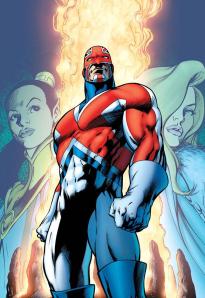 I mean, maybe I’ve just been more exposed to British culture than most American kids, thanks to growing up with a British stepfather (Captain Britain was born in Essex, by the way. What UP, parents who read our blog?) but how is Captain Britain not more popular in the States, or even in the UK?
I mean, maybe I’ve just been more exposed to British culture than most American kids, thanks to growing up with a British stepfather (Captain Britain was born in Essex, by the way. What UP, parents who read our blog?) but how is Captain Britain not more popular in the States, or even in the UK?
Fun Fact #1: The designation of the main Marvel Universe as “Earth 616?” Yeah. That was thanks to David Thorpe’s early eighties revamp of Captain Britain.
Fun Fact #2: You know who Psylocke is, right? Of course you do! But were you aware that Captain Britain is her brother?
(Ok, the fankids probably knew #2, but High Five!’s more casual readers probably didn’t.)
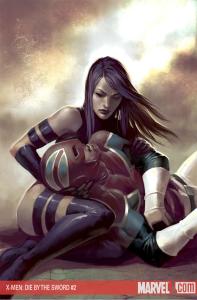 Besides that fact that Brian Braddock is a whole hell of a lot more important to the Marvel U than modern continuity would have you believe, the David Thorpe/Alan Moore/Jamie Delano + Alan Davis stories in the early eighties were remarkably ahead of their time. In the first issue of the revamp, Braddock and his sidekick, Jackdaw the elf, are sent by Merlin (yes, that Merlin) to an alternate Earth (238, for anyone keeping track.) Britain of Earth 238 is run by the borderline fascist British National Party and the entire populace is ridiculously violent and hateful. Unbeknownst to the largely ignorant citizens, the alien Lady Saturnyne is hiding out, attempting to “evolve” this dimension by exposing the population to an evolutionary elixir. Apparently, Earth 238 is so backward that it’s retarding the evolution of the entire multiverse.
Besides that fact that Brian Braddock is a whole hell of a lot more important to the Marvel U than modern continuity would have you believe, the David Thorpe/Alan Moore/Jamie Delano + Alan Davis stories in the early eighties were remarkably ahead of their time. In the first issue of the revamp, Braddock and his sidekick, Jackdaw the elf, are sent by Merlin (yes, that Merlin) to an alternate Earth (238, for anyone keeping track.) Britain of Earth 238 is run by the borderline fascist British National Party and the entire populace is ridiculously violent and hateful. Unbeknownst to the largely ignorant citizens, the alien Lady Saturnyne is hiding out, attempting to “evolve” this dimension by exposing the population to an evolutionary elixir. Apparently, Earth 238 is so backward that it’s retarding the evolution of the entire multiverse.
Scuttlebutt is that some of the higher-ups at Marvel had a problem with the “omniverse” storyline in Captain Britain, a concept they deemed a little too DC (which might have something to do with why I like it so much.) But ultimately, both Thorpe & Moore’s storytelling abilities, coupled with Alan Davis’ top-notch art, propel this run to the top of the early eighties comics scrap heap. Many a comics enthusiast can elaborate at length about the renaissance of the medium in the eighties, usually citing Swamp Thing, Animal Man, and Sandman as prime examples of the era’s superhero revamps. But Captain Britain deserves a place on that list, not because the work itself is on par with what Moore, Morrison, and Gaiman later accomplished in what many would call their seminal works, but because Captain Britain’s reinvention and his adventures in the wake of it were an early, pioneering step in the direction that super hero comics would take in the later eighties.
Captain Britain‘s writers were exclusively British themselves – so instead of a national hero written by Americans (which, my god, can you imagine what we might have done to him?), the British comic nerds had a hero who was uniquely, and accurately, British. I mean, this is a guy who can fly, create force fields and generally kick some serious ass – but because his writers themselves were Brits, it was easy to believe that Braddock would stop mid-fight for a cuppa. Which he could get away with because, you know, his villains generally had to take tea breaks too. (In fact, his biggest villain, Mad Jim Jaspers, traveled around in a giant flying tea kettle.) The very idea might seem completely insane to Americans, but to the British (who, by the way, do NOT fuck around when it comes to tea) it is entirely natural. The remarkable use of dialect in the series is also thanks to the British writers, a dropped ‘h’ here, an overemphasized ‘h’ there, dialect in Captain Britain is a pretty good indication of who is good or bad, poor or rich, and thanks to its British creators, it is lettered just so – even a Yank can tell the difference.
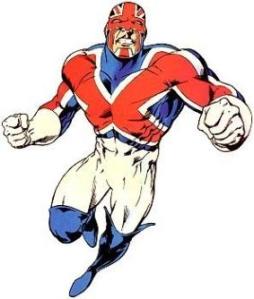 Perhaps the bulk of the credit must go to the artist, Alan Davis, who guided the series through several different writers and was listed as “co-creator” even alongside Alan Moore. In any event, it’s a complete mystery to me that this series isn’t a bigger deal than it is. There exist very few collections of Captain Britain. There are a few affordable trades but the best bang for your buck is the Captain Britain Omnibus
Perhaps the bulk of the credit must go to the artist, Alan Davis, who guided the series through several different writers and was listed as “co-creator” even alongside Alan Moore. In any event, it’s a complete mystery to me that this series isn’t a bigger deal than it is. There exist very few collections of Captain Britain. There are a few affordable trades but the best bang for your buck is the Captain Britain Omnibus which will set you back about $60, but is entirely worth it. Not only is Brian Braddock a much bigger deal than you think he is, but Moore’s run on Captain Britain was one of his earliest works. As far as I know, this is the only volume these issues are compiled in.
Brian Braddock’s got a PhD in physics, superpowers, the hottest sister in the Marvel Universe, and if not for him, Earth 616 would’ve been wiped off the map in the mid-eighties. He might be the most underrated underdog ever, not only in-universe, but in his book’s real world contributions to the medium. Trust me on this, read Captain Britain!
 Normally, I’m a pretty open minded dude. You’d be pretty hard pressed to mention something to me that either puts me off or grosses me out. But, I’ll be damned, it turns out that DC Comics figured out how to do it through one of its Silver Age characters, Comet the Super-Horse.
Normally, I’m a pretty open minded dude. You’d be pretty hard pressed to mention something to me that either puts me off or grosses me out. But, I’ll be damned, it turns out that DC Comics figured out how to do it through one of its Silver Age characters, Comet the Super-Horse.
Comet was a by-product of DC’s love affair with slapping the “super” prefix on any and every animal they could think of (see: Streaky, Krypto, Beppo), except he had one big, big difference. You see, Comet wasn’t always a horse. In the beginning, Comet was a Greek centaur named Biron who was crazy in love with Circe. One day he spotted a rival wizard, Maldor, trying to poison the well she drank from. Biron ended up saving her life and, as a reward, she decided to use her powers of transforming people into animals and tried to turn Biron into a man. Instead, she done fucked up something fierce and he ended up being all horse. As 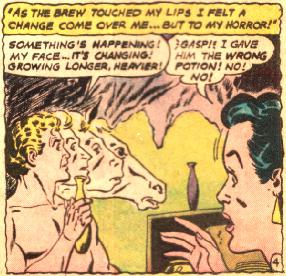 a consolation prize, she gave him a shit-ton of superpowers including flight, super strength, immortality, and telepathy. He blasted off into space and eventually caught sight of Supergirl’s rocket blasting through space. I guess being a space-horse is boring enough, so he followed her to Earth and watched her grow up to be Supergirl. Also, his ass fell in looooove.
a consolation prize, she gave him a shit-ton of superpowers including flight, super strength, immortality, and telepathy. He blasted off into space and eventually caught sight of Supergirl’s rocket blasting through space. I guess being a space-horse is boring enough, so he followed her to Earth and watched her grow up to be Supergirl. Also, his ass fell in looooove.
Later on, in September 1962’s Action Comics #292 (his first printed appearance), he decides to telepathically invade her dreams (if that doesn’t throw some serious creepy vibes your way, I dunno what will). She ends up vacationing at a Supergirl-themed dude ranch (which makes no sense) and, holy shit, Comet just happens to be one of the horses. They become fast buddies and shenanigans ensue. In Action Comics #311, Superman asks Comet to travel to the red-sunned “sorcerer’s planet” Zerox to do their ruler, Prince Endor, a favor. In return, Endor grants him the ability turn into a powerless human anytime a comet goes through our solar system. And what does Comet do when he happens to get home just as a comet is zooming past? He enters a rodeo under the name Bronco Bill  Starr, gets saved from a bull by Supergirl, and macks on her like there’s no tomorrow.
Starr, gets saved from a bull by Supergirl, and macks on her like there’s no tomorrow.
He ran around with the Legion of Super-Pets and kept on helping out Supergirl (usually with his telepathic powers) until his last appearance in April 1970’s Adventure Comics #392. Well, sorta last appearance. There’s some dude with horse DNA going by the name Comet who debuted in late-1990’s Supergirl, but he’s so different/idiotic that I don’t think they’re really related. He also popped up as a statue in a museum in Legion of Three Worlds #1, but that was probably just a Geoff Johns-style tip of the hat (although, you know Sterling Gates, modern Supergirl does seem to be missing something).
I guess technically Comet only got down with Supergirl when he was human, but you know what? There’s still that little thing in the back of your head going, “Hey. He’s a horse. And even when he wasn’t a horse,  from the waist down, he was still a fucking horse.” Let that simmer. What would happen if “Bill Starr” hooked up with Supergirl and he ended up turning back into Mr. Ed? That’s, like, that Catherine the Great legend times a bajillion (also, ew). Anyways, enjoy having that visual for the rest of your life.
from the waist down, he was still a fucking horse.” Let that simmer. What would happen if “Bill Starr” hooked up with Supergirl and he ended up turning back into Mr. Ed? That’s, like, that Catherine the Great legend times a bajillion (also, ew). Anyways, enjoy having that visual for the rest of your life.
 I know I promised this article like, a month ago in that post about the apes, but bear with me, I’ve been busy. Also, I forgot. Also, shut up.
I know I promised this article like, a month ago in that post about the apes, but bear with me, I’ve been busy. Also, I forgot. Also, shut up.
I freaking love Detective Chimp. Wait, why do I love Detective Chimp? Is it the fact he’s a raging alcoholic? That he is a member of the Shadowpact, a sort of supernatural police force? That he’s been around since August, 1952? That he was once Doctor Fate? That he can speak and write in every language ever (no exaggeration)? Or maybe it’s that he’s a freaking detective chimpanzee (and occasionally helps freaking Batman via instant message)? Oh, it’s totally yes to all of these.
 In every version of Detective Chimp’s (aka Bobo T. Chimpanzee aka Magnificent Finder of Tasty Grubs) origin, he started out as a regular old chimp. He was part of a circus sideshow where he’d wear a Holmes-style hat and solved little crimes by hitting “yes” or “no” buttons. His handler, Fred Thorpe, was good to him and so Bobo loved him back. Now, there are two ways this can go. There’s the pre-Crisis version where Thorpe dies, Bobo helps the sheriff solve the murder, and Bobo ends up becoming the sidekick of Rex the Wonder Dog. Then there’s the post-Crisis Day of Vengeance version where Bobo just kinda slips away in Florida and meets up with Rex. Either way, they end up sipping from the Fountain of Youth and Bobo becomes Detective Chimp! Unfortunately, chimps don’t have the same legal benefits as people, so when none of the clients from Bobo’s detective agency paid their bills, he got closed down and took up drinking. Tough break.
In every version of Detective Chimp’s (aka Bobo T. Chimpanzee aka Magnificent Finder of Tasty Grubs) origin, he started out as a regular old chimp. He was part of a circus sideshow where he’d wear a Holmes-style hat and solved little crimes by hitting “yes” or “no” buttons. His handler, Fred Thorpe, was good to him and so Bobo loved him back. Now, there are two ways this can go. There’s the pre-Crisis version where Thorpe dies, Bobo helps the sheriff solve the murder, and Bobo ends up becoming the sidekick of Rex the Wonder Dog. Then there’s the post-Crisis Day of Vengeance version where Bobo just kinda slips away in Florida and meets up with Rex. Either way, they end up sipping from the Fountain of Youth and Bobo becomes Detective Chimp! Unfortunately, chimps don’t have the same legal benefits as people, so when none of the clients from Bobo’s detective agency paid their bills, he got closed down and took up drinking. Tough break.
When Rex the Wonder Dog was canceled in 1959, Detective Chimp pretty much got buried with it. He didn’t return again until a co-feature in 1981’s DC Comics Presents#35 entitled “Whatever Happened to Rex the Wonder Dog?” After this, he was quietly snuck into one panel in 1985’s Crisis on Infinite Earths #11 and from then on occasionally popped up in other books as comic relief.
 Finally, in 2005 Bill Willingham (yeah, the Fables guy) did an Infinite Crisis tie-in called Day of Vengeance which put the good detective back in the spotlight. He formed the Shadowpact to combat the newly host-less Spectre, who was going batshit crazy after being tricked by Eclipso into thinking that all magic was evil. They stop the Spectre, but end up losing Hammond Hall, the current Doctor Fate in the process. Captain Marvel chucked the helmet into space so it could seek out whoever was worthy, and it ended up landing back down and conking Bobo in the dome. For the duration of the Helmet of Fate: Detective Chimp (man, I have no idea why I don’t own this), he was Doctor Fate. In the end, he realizes he isn’t worthy, throws it on to the next guy, and keeps rolling with the Shadowpact. He was most recently spotted (along with the rest of the Shadowpact team) in Keith Giffen’s Reign in Hell limited series.
Finally, in 2005 Bill Willingham (yeah, the Fables guy) did an Infinite Crisis tie-in called Day of Vengeance which put the good detective back in the spotlight. He formed the Shadowpact to combat the newly host-less Spectre, who was going batshit crazy after being tricked by Eclipso into thinking that all magic was evil. They stop the Spectre, but end up losing Hammond Hall, the current Doctor Fate in the process. Captain Marvel chucked the helmet into space so it could seek out whoever was worthy, and it ended up landing back down and conking Bobo in the dome. For the duration of the Helmet of Fate: Detective Chimp (man, I have no idea why I don’t own this), he was Doctor Fate. In the end, he realizes he isn’t worthy, throws it on to the next guy, and keeps rolling with the Shadowpact. He was most recently spotted (along with the rest of the Shadowpact team) in Keith Giffen’s Reign in Hell limited series.
Anywho, I pretty much love this character because of how fucking absurd he is. I mean, he runs around drinking from a flask, saving the world from demi-gods, in a shirt that says “everybody sucks but me.” Long ways to go, for a guy who played second banana to the puppy dog equivalent to Captain America. My only question, why can’t I find any evidence of there ever being a Detective Chimp action figure?
 I love Abigail Brand. I’ve wanted to dye my hair green ever since she first showed up during Whedon’s Astonishing X-Men
I love Abigail Brand. I’ve wanted to dye my hair green ever since she first showed up during Whedon’s Astonishing X-Men run as the head of S.W.O.R.D. – the CIA to S.H.I.E.L.D.’s FBI – with her alien-green hair and sweet sunglasses.
Whedon’s golden-touch when it comes to kick ass female characters was turned to eleven when he created Abby. S.W.O.R.D. (Sentient World Observation and Response Department), headquartered on an orbital space station, deals with alien threats to Earth and Abby’s in charge. It’s kind of like if Fox Mulder had Dana Scully’s anatomy and got to chill out on the JLA Watchtower. From the word go, Abby was her own woman – a lot of second and third string characters in the Marvel U don’t really stand up on their own because they were created to fit a team dynamic, but Abby blows that all to hell. Homegirl’s saved the world from countless alien threats – she even snuck on board a Skrull ship during the invasion and killed every single Skrull on board by her damned self.
And she’s a good shot too, she targeted a cannon on a Ghost Box, FROM SPACE, and saved the world from yet another interdimensional invasion.
She’s got good taste in men; she’s dating Beast. Who, while covered in blue fur, is actually a human, so everyone just calm down. Brand herself is half alien, and apparently her father was a big blue thing too, so Beast’s appearance doesn’t phase her one bit. Her half-alien heritage has given her some sweet powers of her own; she can generate heat and speak in alien languages no other human could physically vocalize. It’s about damn time Beast got a real AWESOME girlfriend. (Watching him leap to her rescue while her escape pod plummeted to earth in this week’s Astonishing X-Men was awesome – “I mean, I’ve lost girlfriends before, but losing one to a ballistic re-entry in half a spaceship is just going to seem gauche when people ask.”)
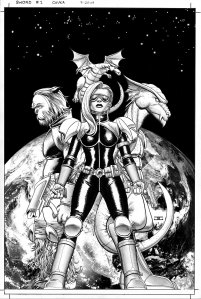 This is a woman who can kill scads of Skrulls, cry when she sees the destruction they’ve wrought, then turn around and fuck their shit up even more. Abby can be gruff, but she’s doing Nick Fury’s job on a galactic scale, you’d be a bit cantankerous too!
This is a woman who can kill scads of Skrulls, cry when she sees the destruction they’ve wrought, then turn around and fuck their shit up even more. Abby can be gruff, but she’s doing Nick Fury’s job on a galactic scale, you’d be a bit cantankerous too!
As director of S.W.O.R.D., Abby is basically on constant Galactus watch. I feel safer already. Hopefully we’ll see a lot of her in Spider-Woman and I can’t freakin’ wait for S.W.O.R.D. #1, starring Brand, Lockheed, and Beast. Now I just need to figure out who I’m going to commission my “Abigail Brand, Agent of S.W.O.R.D.” classic Steranko-style Nick Fury cover mock up from. It’s gonna rule.
Angel and Beak: A Testament to the Benefits of Unplanned Teenage Pregnancy
Posted on: September 22, 2009
As was a major theme of “New X-Men,” both of these characters were publicly chastised after their powers manifest at puberty (Beak by Dutch school children and Angel by her abusive step-father). They hate school (with the exception of the constant lessons between Beast and Beak) and they hate themselves until they have eachother. Then nothing else in the world matters. And then sometime between fighting the U-Men and getting awards for beating the U-Men,There are few titles that I loved as much as Morrison’s “New X-Men.” It pretty much had everything: intriguing new characters (fuck yeah, Xorn!), heartbreak (oh no, Xorn!), betrayal (man, fuck you, Xorn). And of these new characters, there are three who ultimately stand out above the rest and deserve the Underrated Underdogs treatment: Fantomex (which I’m soooo gonna let Jon handle), Beak, and Angel.
There are few titles that I loved as much as Morrison’s New X-Men. It pretty much had everything: intriguing new characters (fuck yeah, Xorn!), heartbreak (oh no, Xorn!), betrayal (man, fuck you, Xorn). And of these new characters, there are three who ultimately stand out above the rest and deserve the Underrated Underdogs treatment: Fantomex (which I’m soooo gonna let Jon handle), Beak, and Angel.
But why do I give a two shits about Beak and Angel?
They’re two balls of teenage angst, for one! They are seriously the best representations of two high school kids I have ever seen in a comic book. Look, Beak claims he’s “straight edge hardcore” (we all listened to Minor Threat when we were 16). Angel is labeled as a “skank” by the other X-Kids (if there’s anything teenage girls hate it’s teenage girls!). Yet, one kiss and they’re in love forever (your first relationship was totally like that, admit it). Put them together, and you have one of the biggest “awww” couples of comics (why I forgot them on the Top Ten Second String Comic Couples, I’ll never know).
As was a major theme of New X-Men, both of these characters were publicly chastised after their powers manifest at puberty (Beak by Dutch school children and Angel by her abusive step-father). They hate being in the “special class” at school (with the exception of the constant lessons between Beast and Beak) and they hate themselves until they have each other. Then nothing else in the world matters. And then sometime between fighting the U-Men and getting awards for beating the U-Men, Beak got Angel preggers. Three issues later, they had six babies with wings (fastest gestation ever!).
Following this, Beak proved several times over just how commited he was to Angel and the kids. When it turned out Xorn was (SPOILER ALERT IF YOU ARE A FEW YEARS BEHIND, SRSLY SKIP TO THE NEXT PARAGRAPH) Magneto in disguise and he turned the “special class” into the new Brotherhood of Mutants, Beak questioned the conversion to evil and got the shit beat out of him by Magneto. Then, to get Angel and the kids back, Beak fucking took on Magneto again. It’s adorable and it’s brutal! It’s adorabrutal!
Anywho, Beak, Fantomex, and the X-Men took Magneto down and then they lived happily ever after.
As if! Comics don’t work that way, dummy.
I’ll admit, after New X-Men, I never read any more of the story lines with Beak or Angel. I never read any other titles with Beak, with the exception of a little House of M. Beak ended up in the Exiles, skipped around the Marvel multiverse for a while, came back, dealt with a funky reality where Angel was a model and the kids didn’t exist, and then got hit with Scarlet Witch’s crazy fit.
Apparently, Scarlet Witch made Beak, Angel, and the kids (save Tito) humans (boring!). Then they got technologically-enhanced suits and implants and joined the New Warriors (what?). Now they just look like stupid ol’ people with stupid ol’ powers with the stupid new names of Blackwing and Tempest. At least they’re still together!
All right, let’s close this fucking thing. If Marvel somehow gets these two characters back into pre-Generation M shape, I would be so fucking into that. I mean, this is a comic book in the Marvel Universe. They can totally pull a Jean Grey and revert these characters back to when they were awesome! I mean, it doesn’t even have to be Morrison! I’m pretty sure that given to the likes of Jim McCann or Ed Brubaker or Brian Michael Bendis, it’d be totally rad! It could be the Marvel equivalent to Green Arrow/Black Canary!
Get on it, Quesada!
